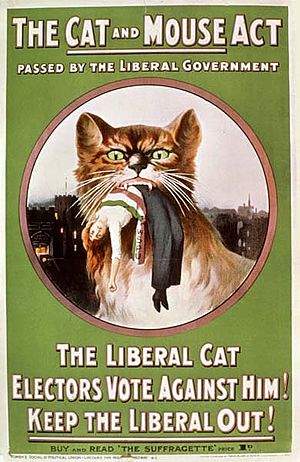Annie Kenney facts for kids
Quick facts for kids
Annie Kenney
|
|
|---|---|

Annie Kenney in 1909
|
|
| Born |
Ann Kenney
13 September 1879 Springhead, Oldham, England
|
| Died | 9 July 1953 (aged 73) Hitchin, Hertfordshire, England
|
| Nationality | British |
| Occupation | Political activism and trade unionism |
| Known for | Political activist and suffragette for the Women's Social and Political Union (WSPU) |
| Spouse(s) | James Taylor |
| Children | 1 |
| Relatives | Sarah (Nell), Jessie, Jenny and Kitty (sisters) |
Ann Kenney (born September 13, 1879 – died July 9, 1953) was a brave English woman. She was a working-class suffragette and a leader in the fight for women's right to vote. She helped start the first London branch of the Women's Social and Political Union (WSPU).
Annie Kenney became famous in 1905. She and Christabel Pankhurst were arrested for asking a politician about votes for women. This event helped start a new, more active phase in the fight for women's suffrage in the UK. Annie was friends with many important suffragettes, including Emmeline Pethick-Lawrence, Mary Blathwayt, and Christabel Pankhurst.
Contents
Annie Kenney's Early Life
Annie Kenney was born in 1879 in Springhead, Greater Manchester. She was one of twelve children. Her parents encouraged their children to read, debate, and learn about socialism.
Annie started working part-time in a cotton mill when she was 10 years old. She also went to school. By age 13, she worked full-time, doing 12-hour shifts. Her job was to help with the threads on the weaving machines. She stayed at the mill for 15 years. During this time, she was involved in trade unions and studied on her own. She also encouraged her co-workers to read.
Fighting for Women's Rights
Annie Kenney joined the Women's Social and Political Union (WSPU) in 1905. She and her sister Jessie heard Christabel Pankhurst speak. Annie felt that a big change was coming in her life. She started visiting the Pankhursts weekly to learn how to speak in public. She also handed out leaflets about women's right to vote.
In October 1905, Annie and Christabel Pankhurst went to a political meeting in Manchester. They interrupted the meeting to ask: "Will the Liberal government give votes to women?" They held up a banner that said "Votes for Women." They were removed from the meeting and arrested. Annie was put in prison for three days. She was jailed 13 times in total for her protests.

Emmeline Pankhurst, a leader of the suffragette movement, later wrote about this event. She said it was the start of a new kind of campaign in England. She noted that they often interrupted meetings and were sometimes hurt.
In 1906, Annie Kenney and Minnie Baldock started the first WSPU branch in London. Annie was arrested again that year for trying to meet with a government official. She chose to go to prison for six weeks instead of stopping her campaigning. Annie traveled around the country, speaking to working women about their rights.
Annie became a very important leader in the WSPU. In 1913, she helped arrange for working-class women to speak with politicians. These women explained their difficult working conditions. They hoped that having the right to vote would help them improve their lives.
Annie Kenney was involved in many protests. She was force-fed many times when she went on hunger strike in prison. She also spoke out against the "Cat and Mouse Act." This law allowed sick prisoners (like those on hunger strike) to be released. But once they got better, they were sent back to prison to finish their sentence. Annie was given a special medal called the "Hunger Strike Medal" for her bravery.
When World War I started in 1914, Emmeline Pankhurst asked the suffragettes to stop their protests. She encouraged women to help with the war effort instead. Many women took on jobs that men usually did, as the men were away fighting. Annie Kenney traveled to different parts of the UK, France, and the United States. She encouraged people to support the war work.
In 1921, Annie Kenney wrote a series of articles called "Revelations." In these articles, she shared her experiences as a suffragette. She wrote about her life as a factory girl and how she joined the movement. She also described her public speeches and her arrests.
Annie Kenney's Later Life
After women over 30 gained the right to vote in 1918, Annie Kenney married James Taylor. They settled in Letchworth, Hertfordshire, and had a son named Warwick.
Annie Kenney passed away on July 9, 1953, at the age of 73. Her family scattered her ashes on Saddleworth Moor.
Remembering Annie Kenney
Annie Kenney is remembered for her important work.
- In 1999, a blue plaque was put up in her honor at Lees Brook Mill in Lees, where she once worked.
- In 2018, a statue of Annie Kenney was unveiled in front of the Old Town Hall in Oldham.
- Her name is also etched on the base of the statue of Millicent Fawcett in Parliament Square, London. This statue honors many women who fought for suffrage.
Images for kids
-
Adela Pankhurst (standing) and Annie Kenney, pictured in 1909.
See also
 In Spanish: Annie Kenney para niños
In Spanish: Annie Kenney para niños





